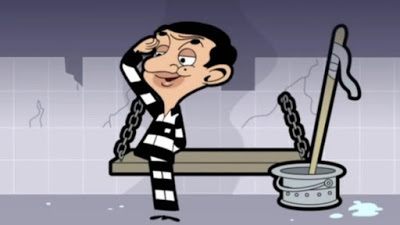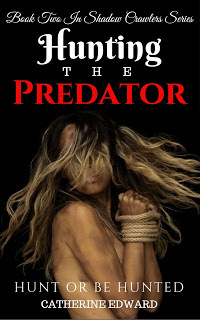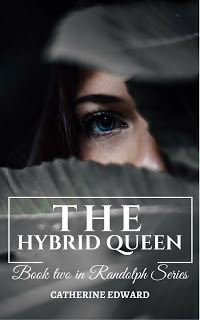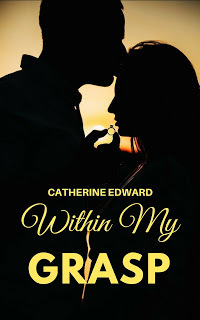Catherine Edward's Blog, page 26
April 10, 2018
My Covers
Published on April 10, 2018 22:23
Limitless Publishing: Marketing Blog: WATTPAD AUTHORS: WIN A PUBLISHING CONTRACT!
Limitless Publishing: Marketing Blog: WATTPAD AUTHORS: WIN A PUBLISHING CONTRACT!: Wattpad authors, we want to publish your work! Enter our contest for a chance to win a publishing contract with Limitless Publishing! ...
DATE:
Wednesday, May 2, 2018
TIME:
12 PM EST - 6 PM EST
WHERE:
Twitter! Using the hashtag: #Pit2LPWattpad
Here are the contest guidelines:
~ Submit your pitch to us on TWITTER using the hashtag: #Pit2LPWattpad. If you do not use this hashtag, we will not be able to see your pitch.
~ In your tweet, also include the link to your Wattpad author profile and your book's GENRE. Below you will find a list of genres. Please include the genre in your pitch using a #hashtag like done so below.
#YA = Young Adult
#NA = New Adult
#P = Paranormal
#PNR = Paranormal Romance
#WF = Woman’s Fiction
#E = Erotica or Erotic Romance
#CR = Contemporary Romance
#HF = Historical Fiction
#HR = Historical Romance
#W = Western
#WR = Western Romance
#T = Thriller
#SF = Science Fiction
#F = Fantasy
#S = Suspense
#RS = Romantic Suspense
~ You should have numerous variations of your pitches available to post during the event.
~ You can pitch several manuscripts.
Important information:
If @limitlessbooks favorites your Tweet: CONGRATULATIONS! Your pitch captivated us! Please submit a manuscript to submissions@limitlesspublishing.com
Follow submission guidelines when submitting your manuscript. You can read more about those here: http://www.limitlesspublishing.net/submissions/#guidelines
Please DO NOT favorite any pitches. Only @limitlessbooks will be doing so.
WINNER:
After the contest closes, all entries will be evaluated objectively by the submissions team. The winning author will be notified via email upon being chosen and then a public announcement will be made.
Don't forget...
Your tweet should include #Pit2LPWattpad + your pitch + your genre using the hashtags explained above + the link to your Wattpad author profile.
Be kind. Be courteous. Be professional.
Have fun and good luck!
DATE:
Wednesday, May 2, 2018
TIME:
12 PM EST - 6 PM EST
WHERE:
Twitter! Using the hashtag: #Pit2LPWattpad
Here are the contest guidelines:
~ Submit your pitch to us on TWITTER using the hashtag: #Pit2LPWattpad. If you do not use this hashtag, we will not be able to see your pitch.
~ In your tweet, also include the link to your Wattpad author profile and your book's GENRE. Below you will find a list of genres. Please include the genre in your pitch using a #hashtag like done so below.
#YA = Young Adult
#NA = New Adult
#P = Paranormal
#PNR = Paranormal Romance
#WF = Woman’s Fiction
#E = Erotica or Erotic Romance
#CR = Contemporary Romance
#HF = Historical Fiction
#HR = Historical Romance
#W = Western
#WR = Western Romance
#T = Thriller
#SF = Science Fiction
#F = Fantasy
#S = Suspense
#RS = Romantic Suspense
~ You should have numerous variations of your pitches available to post during the event.
~ You can pitch several manuscripts.
Important information:
If @limitlessbooks favorites your Tweet: CONGRATULATIONS! Your pitch captivated us! Please submit a manuscript to submissions@limitlesspublishing.com
Follow submission guidelines when submitting your manuscript. You can read more about those here: http://www.limitlesspublishing.net/submissions/#guidelines
Please DO NOT favorite any pitches. Only @limitlessbooks will be doing so.
WINNER:
After the contest closes, all entries will be evaluated objectively by the submissions team. The winning author will be notified via email upon being chosen and then a public announcement will be made.
Don't forget...
Your tweet should include #Pit2LPWattpad + your pitch + your genre using the hashtags explained above + the link to your Wattpad author profile.
Be kind. Be courteous. Be professional.
Have fun and good luck!
Published on April 10, 2018 21:29
March 27, 2018
March 25, 2018
Review: Diadem
Published on March 25, 2018 09:56
March 23, 2018
March 17, 2018
Royalty Free Image Websites for Book Covers
Royalty Free Image Websites for Book Covers

Royalties are a percentage of revenue given as compensation to artists for their work. Most of the time royalties are used in place of upfront costs, but some artists charge both upfront and royalties.In the context of photography, a royalty-based stock photo means that if the photo helps you make money in some way, you owe a percentage of what you earn back to the photographer.Luckily for you, all of these websites are royalty-free, so once you download an image (some are free, some have upfront costs), it's yours to use without having to worry about any recurring costs. However, keep in mind that royalty-free doesn't necessarily mean attribution-free.The High quality images found in these below websites are licensed under creative commons. So, you can use it without fear of copyright claims.https://commons.wikimedia.orgwww.pixabay.comwww.unsplash.comwww.pexels.comwww.splitshire.comwww.mmtstock.comwww.skitterphoto.comwww.freerangestock.comwww.freeimages.comwww.imagesource.com/royalty-freewww.morguefile.comwww.istockphoto.com/inwww.gettyimages.in/creative-images/royaltyfreewww.fotolia.com/Info/Imageshttps://stocksnap.io/https://burst.shopify.comwww.gratisography.comhttps://negativespace.cowww.Freestock.orgwww.lifeofpix.comhttp://picography.co/www.littlevisuals.cowww.deathtothestockphoto.comwww.foodiesfeed.comwww.picjumbo.comwww.imcreator.com/freewww.nos.twnsnd.cowww.jaymantri.comwww.kaboompics.comwww.splitshire.comhttp://epicantus.tumblr.com/www.shotstash.comwww.styledstock.cowww.thinkstockphotos.in/https://www.flickr.com/creativecommons/wwww.jeshoots.comOkay, last but not least. You always have the life saviour our google. Filter the search options and choose "Labeled for reuse" to download Royalty free images.Shutterstock.com images are not free. So be warned. Then there is www.kozzi.com, again this is not free but you will have wide range of photos to choose from, if you are willing to pay.

Royalties are a percentage of revenue given as compensation to artists for their work. Most of the time royalties are used in place of upfront costs, but some artists charge both upfront and royalties.In the context of photography, a royalty-based stock photo means that if the photo helps you make money in some way, you owe a percentage of what you earn back to the photographer.Luckily for you, all of these websites are royalty-free, so once you download an image (some are free, some have upfront costs), it's yours to use without having to worry about any recurring costs. However, keep in mind that royalty-free doesn't necessarily mean attribution-free.The High quality images found in these below websites are licensed under creative commons. So, you can use it without fear of copyright claims.https://commons.wikimedia.orgwww.pixabay.comwww.unsplash.comwww.pexels.comwww.splitshire.comwww.mmtstock.comwww.skitterphoto.comwww.freerangestock.comwww.freeimages.comwww.imagesource.com/royalty-freewww.morguefile.comwww.istockphoto.com/inwww.gettyimages.in/creative-images/royaltyfreewww.fotolia.com/Info/Imageshttps://stocksnap.io/https://burst.shopify.comwww.gratisography.comhttps://negativespace.cowww.Freestock.orgwww.lifeofpix.comhttp://picography.co/www.littlevisuals.cowww.deathtothestockphoto.comwww.foodiesfeed.comwww.picjumbo.comwww.imcreator.com/freewww.nos.twnsnd.cowww.jaymantri.comwww.kaboompics.comwww.splitshire.comhttp://epicantus.tumblr.com/www.shotstash.comwww.styledstock.cowww.thinkstockphotos.in/https://www.flickr.com/creativecommons/wwww.jeshoots.comOkay, last but not least. You always have the life saviour our google. Filter the search options and choose "Labeled for reuse" to download Royalty free images.Shutterstock.com images are not free. So be warned. Then there is www.kozzi.com, again this is not free but you will have wide range of photos to choose from, if you are willing to pay.

Published on March 17, 2018 23:58
March 16, 2018
Types Of Plagiarism (For students in colleges/schools)
Types Of Plagiarism (For students in colleges/schools)

Souce: www.scanmyessay.comThe scanmyessay website has awesome tool for plagiarism check. Check them out today.Now that we have stressed the seriousness of plagiarism, it is important for you to look in more detail at the different types of plagiarism there are: after all, students often plagiarise due to ignorance or carelessness, rather than intent.Different types of plagiarism:Deliberate plagiarism:This needs little explanation. Deliberate plagiarism is the simple - and totally wrong - act of attempting to pass off someone else's work as your own.Paraphrasing:This type of plagiarism is a little more strategic - it involves reading a few texts, writing down a few key sentences, changing the words around, and throwing in a few quotes and citations to throw your tutor off the scent: then, 'hey presto', you have the perfect essay, right? Wrong!Your tutors have read those books and seen this method before. As with the first example, this type of plagiarism can only be done deliberately and it won't work.Patchwork paraphrasing:This is much the same as the above, except that it involves reading (and stealing) from more books and 'patching' their ideas together - this, too, is easily detectable, always deliberate and definitely deceitful, aided and abetted by online plagiarism!Bluffing:This involves reading texts, selecting key phrases and then writing down the ideas so that they seem different, though the ideas are actually the same - this type of plagiarism is bluffing in the worst way, because you are pretending that you have ownership of certain ideas in order to fool others into thinking you know more than you do.Stitching sources:This type of plagiarism is within the 'grey zone' because all the sources used are usually correctly cited, but the student has failed to develop their analytical skills to enable them to work effectively and produce work that is truly their own. This is still plagiarism, but is more likely to be accidental as a result of inexperience.Using a copy of your own work:This one may surprise you: plagiarism of this type is not based on stealing the work of others, but on reworking your own. You may have covered the topic before and gained a good grade; if you are now short on time, it can be easy to think that you can piece your old work together with your new work and produce a successful amalgam. Unfortunately, you can't get two grades (or degrees) for the same work, so even if you do this without knowing that it's wrong, it is still classed as plagiarism.All of the above are types of plagiarism, to a greater or lesser degree, and should be avoided at all cost!

Souce: www.scanmyessay.comThe scanmyessay website has awesome tool for plagiarism check. Check them out today.Now that we have stressed the seriousness of plagiarism, it is important for you to look in more detail at the different types of plagiarism there are: after all, students often plagiarise due to ignorance or carelessness, rather than intent.Different types of plagiarism:Deliberate plagiarism:This needs little explanation. Deliberate plagiarism is the simple - and totally wrong - act of attempting to pass off someone else's work as your own.Paraphrasing:This type of plagiarism is a little more strategic - it involves reading a few texts, writing down a few key sentences, changing the words around, and throwing in a few quotes and citations to throw your tutor off the scent: then, 'hey presto', you have the perfect essay, right? Wrong!Your tutors have read those books and seen this method before. As with the first example, this type of plagiarism can only be done deliberately and it won't work.Patchwork paraphrasing:This is much the same as the above, except that it involves reading (and stealing) from more books and 'patching' their ideas together - this, too, is easily detectable, always deliberate and definitely deceitful, aided and abetted by online plagiarism!Bluffing:This involves reading texts, selecting key phrases and then writing down the ideas so that they seem different, though the ideas are actually the same - this type of plagiarism is bluffing in the worst way, because you are pretending that you have ownership of certain ideas in order to fool others into thinking you know more than you do.Stitching sources:This type of plagiarism is within the 'grey zone' because all the sources used are usually correctly cited, but the student has failed to develop their analytical skills to enable them to work effectively and produce work that is truly their own. This is still plagiarism, but is more likely to be accidental as a result of inexperience.Using a copy of your own work:This one may surprise you: plagiarism of this type is not based on stealing the work of others, but on reworking your own. You may have covered the topic before and gained a good grade; if you are now short on time, it can be easy to think that you can piece your old work together with your new work and produce a successful amalgam. Unfortunately, you can't get two grades (or degrees) for the same work, so even if you do this without knowing that it's wrong, it is still classed as plagiarism.All of the above are types of plagiarism, to a greater or lesser degree, and should be avoided at all cost!

Published on March 16, 2018 23:27
March 15, 2018
How long do you go to jail for copyright infringement?
How long do you go to jail for copyright infringement?

US:According to the U.S. Department of Justice, first-time copyright infringement cases can carry a fine of up to $250,000 and up to five years in prison. If you get caught more than once in a copyright-infringement case, you could face additional fines of up to $250,000 and up to 10 years in prison. India:The Copyright Act 1957 provides three kinds of remedies - administrative remedies, civil remedies and criminal remedies.[30] The administrative remedies provided under the statute include detention of the infringing goods by the customs authorities.The civil remedies are provided under Chapter XII of the Copyright Act 1957 and the remedies provided include injunctions, damages and account of profits. The criminal remedies are provided under Chapter XIII of the statute and the remedies provided against copyright infringement include imprisonment (up to 3 years) along with a fine (up to 200,000 Rupees).Canada:According to section 34(4) of the copyright act, specific penalties will be decided by the court. Section 35(1) states that an infringer is liable for the financial gain made through infringement, and "such damages to the owner of the copyright as the owner has suffered due to the infringement". A copyright holder can instead elect to protect his/her copyright under section 38.1, which allows for "a sum of not less than $100 or more than $5,000 as the court considers just." for all non-commercial infringement, and $500 up to $20,000 for each commercial infringement.In addition to the civil penalties described above, Section 42(1) of the copyright act sets out a number of criminal offences. These primarily deal with infringement that involves sale or rental of copyrighted materials, and can result in fines of up to $1,000,000 or prison sentences of up to 2 years for indictment. For a summary conviction, the maximum fine is $25,000 and prison term is limited to 6 months.According to Section 44 of the copyright act, copyright owners may apply to have copies of their work that, were they made in Canada would be infringing, and are about to be, or have been, imported into Canada dealt with by the Canada Border Services Agency. In these cases, such copies can be detained, and eventually destroyed or handed over to the copyright holder, at the discretion of the court.
Australia:The court has a wide discretion concerning possible punishments for copyright infringement. A good example of “serious” copyright infringement would be where the offender has built up a business of reproducing and distributing copyrighted material to the public.In this case, there are a number of possible punishments:The court may impose a fine (which can exceed $60,000 for an individual or $300,000 for a company). However, the court's practice in the past has been to rarely impose anything like this maximum and look to mitigating factors such as the defendant's remorse or progress in reform.The court can impose imprisonment for up to five years in some cases. Again, the court would be quite reluctant to do so and would probably prefer financial punishment (a fine being the only option in the case of a company).In addition, the court may make a number of other orders (such as imposing restrictions on the defendant) or ordering the surrender of infringing copies to the copyright owner (usually for the purpose of destroying them). Interestingly, this power of destruction can be exercised by the court even if the defendant is found not guilty.As with many criminal offences, the court can impose high penalties if it views the conduct as very serious. However, as the punishments can vary greatly, the assistance of a good defence lawyer is essential to reduce the likelihood of harsh penalties being imposed.UK:Copyright infringement can lead to substantial penalties, even if the UK legal system is unlikely to hit American levels of awards.Upon conviction in the magistrates' court the maximum term of incarceration in the UK for copyright infringement is 6 months and/or a fine of up to £50,000.
Upon conviction in the Crown Court the maximum term of incarceration in the UK for copyright infringement is 10 years and/or an "unlimited" fine.


US:According to the U.S. Department of Justice, first-time copyright infringement cases can carry a fine of up to $250,000 and up to five years in prison. If you get caught more than once in a copyright-infringement case, you could face additional fines of up to $250,000 and up to 10 years in prison. India:The Copyright Act 1957 provides three kinds of remedies - administrative remedies, civil remedies and criminal remedies.[30] The administrative remedies provided under the statute include detention of the infringing goods by the customs authorities.The civil remedies are provided under Chapter XII of the Copyright Act 1957 and the remedies provided include injunctions, damages and account of profits. The criminal remedies are provided under Chapter XIII of the statute and the remedies provided against copyright infringement include imprisonment (up to 3 years) along with a fine (up to 200,000 Rupees).Canada:According to section 34(4) of the copyright act, specific penalties will be decided by the court. Section 35(1) states that an infringer is liable for the financial gain made through infringement, and "such damages to the owner of the copyright as the owner has suffered due to the infringement". A copyright holder can instead elect to protect his/her copyright under section 38.1, which allows for "a sum of not less than $100 or more than $5,000 as the court considers just." for all non-commercial infringement, and $500 up to $20,000 for each commercial infringement.In addition to the civil penalties described above, Section 42(1) of the copyright act sets out a number of criminal offences. These primarily deal with infringement that involves sale or rental of copyrighted materials, and can result in fines of up to $1,000,000 or prison sentences of up to 2 years for indictment. For a summary conviction, the maximum fine is $25,000 and prison term is limited to 6 months.According to Section 44 of the copyright act, copyright owners may apply to have copies of their work that, were they made in Canada would be infringing, and are about to be, or have been, imported into Canada dealt with by the Canada Border Services Agency. In these cases, such copies can be detained, and eventually destroyed or handed over to the copyright holder, at the discretion of the court.
Australia:The court has a wide discretion concerning possible punishments for copyright infringement. A good example of “serious” copyright infringement would be where the offender has built up a business of reproducing and distributing copyrighted material to the public.In this case, there are a number of possible punishments:The court may impose a fine (which can exceed $60,000 for an individual or $300,000 for a company). However, the court's practice in the past has been to rarely impose anything like this maximum and look to mitigating factors such as the defendant's remorse or progress in reform.The court can impose imprisonment for up to five years in some cases. Again, the court would be quite reluctant to do so and would probably prefer financial punishment (a fine being the only option in the case of a company).In addition, the court may make a number of other orders (such as imposing restrictions on the defendant) or ordering the surrender of infringing copies to the copyright owner (usually for the purpose of destroying them). Interestingly, this power of destruction can be exercised by the court even if the defendant is found not guilty.As with many criminal offences, the court can impose high penalties if it views the conduct as very serious. However, as the punishments can vary greatly, the assistance of a good defence lawyer is essential to reduce the likelihood of harsh penalties being imposed.UK:Copyright infringement can lead to substantial penalties, even if the UK legal system is unlikely to hit American levels of awards.Upon conviction in the magistrates' court the maximum term of incarceration in the UK for copyright infringement is 6 months and/or a fine of up to £50,000.
Upon conviction in the Crown Court the maximum term of incarceration in the UK for copyright infringement is 10 years and/or an "unlimited" fine.

Published on March 15, 2018 12:12
FAQ: Can you go to jail if you plagiarize?
Published on March 15, 2018 12:08
Consequences Of Plagiarism
Consequences Of Plagiarism
 Source: www.scanmyessay.comThe consequences of plagiarism can be extremely serious.If you doubt the severity of the consequences of plagiarism, consider the following:Plagiarism can get you expelled from your course Plagiarism can result in your work being destroyedPlagiarism can result in expulsion from your academic institution Plagiarism can result in legal action The problem is that students today are faced not only with increasing pressure and a consequent temptation to plagiarise, but also with the potential to plagiarise being ever more available via the Internet - for these reasons, plagiarism is on the increase.However, don't fall into the trap of thinking that because more people are tempted to plagiarise that this somehow both reduces its seriousness and the likelihood of your facing plagiarism consequences, as it does neither of these. If you are caught plagiarising, you may not only be removed from your course, but you may never be able to study for a degree again. Over 50,000 students in the UK alone have been caught for plagiarism in the last 3 years.The consequences of plagiarism could seriously endanger your academic career because your record will follow you: should you be compelled to leave your course of study, you will find it extremely difficult to obtain a place elsewhere because no college or university will want a student who has proven themselves to be dishonest and unworthy. These may seem very harsh words, but it is no exaggeration to say that for a moment of foolishness, you may be sacrificing your entire academic career.Should you be caught plagiarising on a longer piece of work, such as a dissertation or thesis, the work will probably be destroyed. In fact, in these cases, your work will be scrutinised even more carefully for any instance of plagiarism and the consequences of any plagiarism discovered will be even more severe because originality is the basis of this type of high-level research, which is expected to be of publication standard.
Source: www.scanmyessay.comThe consequences of plagiarism can be extremely serious.If you doubt the severity of the consequences of plagiarism, consider the following:Plagiarism can get you expelled from your course Plagiarism can result in your work being destroyedPlagiarism can result in expulsion from your academic institution Plagiarism can result in legal action The problem is that students today are faced not only with increasing pressure and a consequent temptation to plagiarise, but also with the potential to plagiarise being ever more available via the Internet - for these reasons, plagiarism is on the increase.However, don't fall into the trap of thinking that because more people are tempted to plagiarise that this somehow both reduces its seriousness and the likelihood of your facing plagiarism consequences, as it does neither of these. If you are caught plagiarising, you may not only be removed from your course, but you may never be able to study for a degree again. Over 50,000 students in the UK alone have been caught for plagiarism in the last 3 years.The consequences of plagiarism could seriously endanger your academic career because your record will follow you: should you be compelled to leave your course of study, you will find it extremely difficult to obtain a place elsewhere because no college or university will want a student who has proven themselves to be dishonest and unworthy. These may seem very harsh words, but it is no exaggeration to say that for a moment of foolishness, you may be sacrificing your entire academic career.Should you be caught plagiarising on a longer piece of work, such as a dissertation or thesis, the work will probably be destroyed. In fact, in these cases, your work will be scrutinised even more carefully for any instance of plagiarism and the consequences of any plagiarism discovered will be even more severe because originality is the basis of this type of high-level research, which is expected to be of publication standard.

 Source: www.scanmyessay.comThe consequences of plagiarism can be extremely serious.If you doubt the severity of the consequences of plagiarism, consider the following:Plagiarism can get you expelled from your course Plagiarism can result in your work being destroyedPlagiarism can result in expulsion from your academic institution Plagiarism can result in legal action The problem is that students today are faced not only with increasing pressure and a consequent temptation to plagiarise, but also with the potential to plagiarise being ever more available via the Internet - for these reasons, plagiarism is on the increase.However, don't fall into the trap of thinking that because more people are tempted to plagiarise that this somehow both reduces its seriousness and the likelihood of your facing plagiarism consequences, as it does neither of these. If you are caught plagiarising, you may not only be removed from your course, but you may never be able to study for a degree again. Over 50,000 students in the UK alone have been caught for plagiarism in the last 3 years.The consequences of plagiarism could seriously endanger your academic career because your record will follow you: should you be compelled to leave your course of study, you will find it extremely difficult to obtain a place elsewhere because no college or university will want a student who has proven themselves to be dishonest and unworthy. These may seem very harsh words, but it is no exaggeration to say that for a moment of foolishness, you may be sacrificing your entire academic career.Should you be caught plagiarising on a longer piece of work, such as a dissertation or thesis, the work will probably be destroyed. In fact, in these cases, your work will be scrutinised even more carefully for any instance of plagiarism and the consequences of any plagiarism discovered will be even more severe because originality is the basis of this type of high-level research, which is expected to be of publication standard.
Source: www.scanmyessay.comThe consequences of plagiarism can be extremely serious.If you doubt the severity of the consequences of plagiarism, consider the following:Plagiarism can get you expelled from your course Plagiarism can result in your work being destroyedPlagiarism can result in expulsion from your academic institution Plagiarism can result in legal action The problem is that students today are faced not only with increasing pressure and a consequent temptation to plagiarise, but also with the potential to plagiarise being ever more available via the Internet - for these reasons, plagiarism is on the increase.However, don't fall into the trap of thinking that because more people are tempted to plagiarise that this somehow both reduces its seriousness and the likelihood of your facing plagiarism consequences, as it does neither of these. If you are caught plagiarising, you may not only be removed from your course, but you may never be able to study for a degree again. Over 50,000 students in the UK alone have been caught for plagiarism in the last 3 years.The consequences of plagiarism could seriously endanger your academic career because your record will follow you: should you be compelled to leave your course of study, you will find it extremely difficult to obtain a place elsewhere because no college or university will want a student who has proven themselves to be dishonest and unworthy. These may seem very harsh words, but it is no exaggeration to say that for a moment of foolishness, you may be sacrificing your entire academic career.Should you be caught plagiarising on a longer piece of work, such as a dissertation or thesis, the work will probably be destroyed. In fact, in these cases, your work will be scrutinised even more carefully for any instance of plagiarism and the consequences of any plagiarism discovered will be even more severe because originality is the basis of this type of high-level research, which is expected to be of publication standard.

Published on March 15, 2018 11:06








